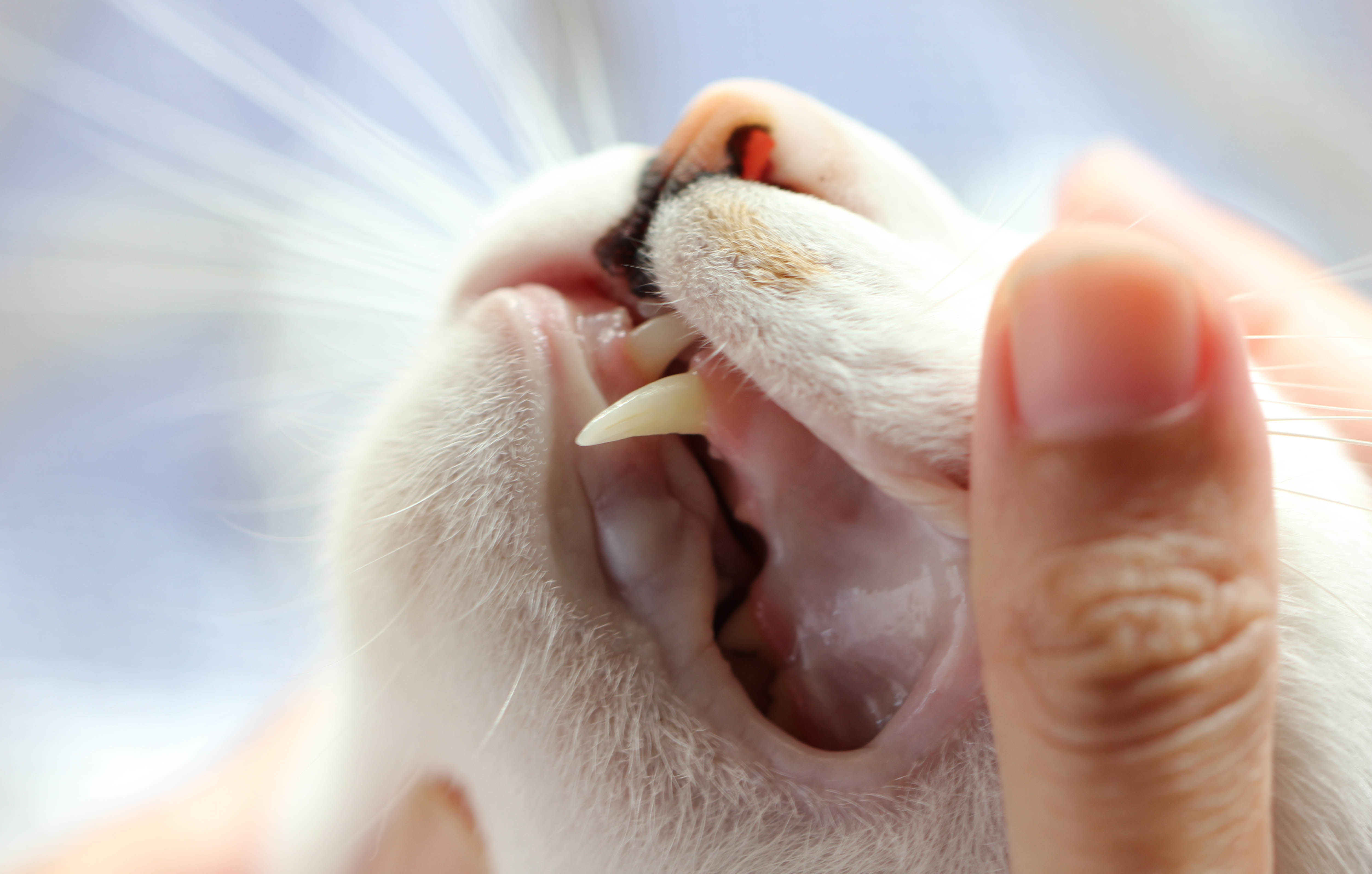Common Feline Dental Problems
February 1st, 2019

Did you know that dental disease is one of the leading medical conditions that affect cats? Cats have two sets of teeth, their baby teeth, and their adult teeth. Baby, or deciduous teeth, are replaced by adult teeth around 6 months of age. Your kitty’s teeth will need to last for a lifetime, which makes it extremely important that you stay alert to any dental problems.
Signs of Dental Disease
Symptoms of dental disease in cats include bad breath, tooth discoloration, swollen or bleeding gums, loose teeth, and difficulty eating. Sometimes it’s hard to tell if your kitty is experiencing oral discomfort. You may notice your furry friend pawing at the mouth or drooling. At times, cats will avoid dry food and will only eat wet food due to dental pain, or in some cases, they may stop eating altogether.
Feline Periodontal Disease
Periodontal disease (gum disease) is a common and serious condition caused by bacteria in dental plaque. If left sitting on your cat’s teeth, plaque builds up and hardens into tartar, which eventually enters under the gum line. This results in the first stage of gum diseases called gingivitis, which is characterized by red, irritated, and inflamed gums. If left untreated, gingivitis can advance to periodontitis, which may damage the supporting tissues around the teeth, potentially leading to tooth loss.
In addition to oral problems, periodontal disease may result in health issues including organ damage. This happens when bacteria from the infected tooth roots and gums enters the bloodstream, a condition called bacteremia.
Tooth Resorption
Tooth resorption is caused by the progressive destruction of a tooth or teeth which results in deepening pits and holes. Once the nerves are exposed, the area becomes intensely painful, and the only treatment option is to extract the affected teeth.
Feline Stomatitis
Stomatitis is a painful condition characterized by severe inflammation and ulceration of the soft tissues in a cat’s mouth. It is caused by an over-active immune system reacting to the bacteria present in dental plaque. While some cats will respond to medical treatment, most cats will require tooth removal to provide relief.
Preventing Dental Disease in Cats
The best way to manage dental disease in cats is prevention. While there are many products available today that help to reduce the accumulation of plaque and tartar, brushing your kitty’s teeth regularly is the best preventive measure you can take. Starting young will help your furry friend adapt to teeth cleaning at home. The American Academy of Feline Practitioners recommends professional veterinary dental cleanings at least one a year. However, annual cleanings may not be advised for various reasons, including the risk of putting your cat under full anesthesia. Discuss the risks and benefits of annual dentals with your veterinarian.
When Should You Contact Your Vet?
If you notice any signs of dental disease in your cat, or if you have questions regarding caring for your furry companion’s dental health, we recommend that you contact All About Cats Veterinary Hospital in the Kirkland area. We will take any measure needed to treat any condition before it progresses. We look forward to helping your precious feline friend enjoy healthy, happy meows for years to come!
Recent Posts
-
Summer Safety Tips for Cat Owners
July 11th, 2024
-
The ABCs of Cat Vaccinations – What Every Cat Owner Should Know
June 5th, 2024
-
Preparing for Travel With or Without Your Feline Friend
May 3rd, 2024
-
How to Feed Cats in a Multiple-Cat Household
April 8th, 2024
-
8 Tips to Get Your Cat in a Carrier
March 5th, 2024
-
Help, My Cat’s Breath Smells!
February 5th, 2024
-
A Quick Guide to Coping with Cat Emergencies
January 8th, 2024
-
Traveling for the Holidays? 6 Things to Do Before Leaving Your Cat
December 14th, 2023
-
What Is Catnip and Is It Safe for Your Cat?
November 2nd, 2023
-
5 Tips for New Cat Owners
October 5th, 2023
-
How Often Should My Cat Have a Health Check?
September 7th, 2023
-
Cat Hairballs – What Do I Need to Know?
August 4th, 2023
-
How to Play with Your Cat: Fun Cat Activities
July 4th, 2023
-
What to Know About Your Cat’s Surgery
June 10th, 2023
-
Licensed Veterinary Technician or Technician Assistant Wanted (Full time or Part time)
May 15th, 2023
-
Why, Oh Why, Does My Cat Hate Water?
May 9th, 2023
-
What’s Wrong with My Cat? Benefits of Whole-Body Radiology
April 5th, 2023
-
Should I Feed My Cat a Grain-Free Diet?
March 6th, 2023
-
Smelly Cat, Smelly Cat – Causes of Feline Odors
February 22nd, 2023
-
5 Ways to Reduce Cat Shedding
January 3rd, 2023
-
Your Cat’s Holiday Stress – How to Help
December 6th, 2022
-
Pet Cancer Awareness Month: Warning Signs to Look Out For
November 2nd, 2022
-
10 Halloween Safety Tips for Cat Owners
October 3rd, 2022
-
Why Is My Cat So Active at Night?
September 7th, 2022
-
Should I Really Microchip My Cat?
August 9th, 2022
-
Ways to Keep Your Cat Safe and Cool This Summer
July 1st, 2022
-
10 Fascinating Facts About Persian Cats
June 1st, 2022
-
How to Correctly Transition Cat Foods
May 6th, 2022
-
What Your Cat’s Tail Is Secretly Trying to Tell You
April 5th, 2022
-
6 Common Household Items That Are Poisonous to Cats
March 1st, 2022
-
How Do I Know if My Cat Needs Dental Surgery?
February 16th, 2022
-
How to Safely Introduce Your Cat to Your New Baby
January 11th, 2022
-
Giving a Cat as a Christmas Gift: How to Do It Responsibly
December 6th, 2021
-
5 Thanksgiving Foods That Are Toxic to Cats
November 5th, 2021
-
Is My Kitty Depressed? Signs to Look For in a Sad Cat
October 7th, 2021
-
Training Tips for New Kitten Owners
September 7th, 2021
-
Taking Your Cat to the Vet: How to Make It a Stress-Free Experience
August 6th, 2021
-
The Origins and History of the Tabby Cat
July 13th, 2021
-
We are hiring a Veterinary Technician!
July 12th, 2021
-
Kitty Claw Control: How and When to Cut Your Cat’s Nails
June 7th, 2021














